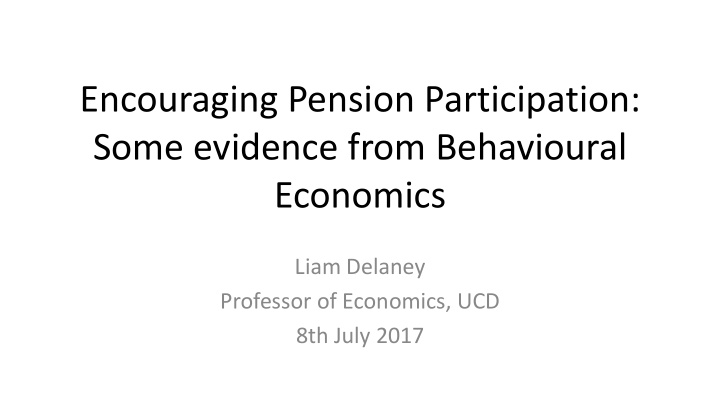



Encouraging Pension Participation: Some evidence from Behavioural Economics Liam Delaney Professor of Economics, UCD 8th July 2017
In this session: • Overview of Behavioural Economics • Evidence on soft-mandatory pensions – Automatic enrolment – Quick enrolment – Save More Tomorrow – Evidence from the UK • Considerations for Ireland
Intro to Behavioural Economics • How do people make economic decisions? – Bounded Rationality: use heuristics to decide when faced with complex decisions/ many options – Bounded Self-Control: inertia and procrastination influence behaviour even if we know best option • Retirement savings literature is a key area of behavioural economics
Automatic Enrolment (1) Madrian and Shea 2001: • Firm introduced auto-enrolment scheme after discrimination issues • By ethnicity : dramatic increase esp. for Black and Hispanic employees (see graph) • By age : younger people showed biggest improvement under scheme
Automatic Enrolment (2) Choi et al 2001: • Extended Madrian and Shea 2001 study – even after 2 years, automatic enrolment had long-lasting positive effect • Default inertia : people tend to stick to the status quo • Important to consider when setting contribution & allocation defaults
Quick Enrolment • Simplify complex decisions to avoid analysis paralysis (whether to save, what contribution, what allocation…) • Choi et al (2006): – Employees tick a box with pre-defined rates and allocations – increases participation by 10 to 20 percentage points! • Carroll et al (2009): – ‘ Active Decision ’ removes issue of who chooses the default settings, require employees to choose one way or another – Best used when employees have very different needs and are likely to procrastinate
Save More Tomorrow (SMaRT) Benartzi and Thaler (2004): • Overcome inertia , impulsivity (hyperbolic discounting), loss aversion : ① Approach employees early before pay increase (impulsivity) ② Increase contribution right after raise (loss aversion) ③ Increase contribution rates after each raise up to ceiling (inertia) • Graph shows significant jump in savings for SMaRT participants
Evidence from the UK • National auto-enrolment scheme introduced in 2012 by UK government • Successful so far: coverage increased by 37 percentage points amongst eligible private sector workers (6.87 million workers) • Average contributions also increased by about a percentage point • Groups who benefitted the most: women, young people, low income earners • Roll-out to small businesses is next – more challenging but UK government optimistic as businesses are well-informed
Considerations for Ireland (1) • Understanding the extent of undersaving : – Are people making other provisions for their pension? Further evidence is required • Anchoring effects : – Default settings in auto-enrolment schemes could be understood as financial advice, could lead to lower savings rates • High fees – Work-place plans could involve high fees – especially for less financially active employees • Substitution effects – Auto-enrolment could subtract from other savings, especially for people who are cash-constrained
Considerations for Ireland (2) • Complexity : – Running an auto-enrolment programme may be particularly complicated for smaller businesses • Wage effects : – Companies may reduce wages to offset the price of the work-place pension plan • Mandatory savings : – Compulsion can be considered as an alternative model, recommended by the OECD • Population targeting : – Should there be an age cutoff? Should self-employed people be covered?
Thank you for your attention
Recommend
More recommend